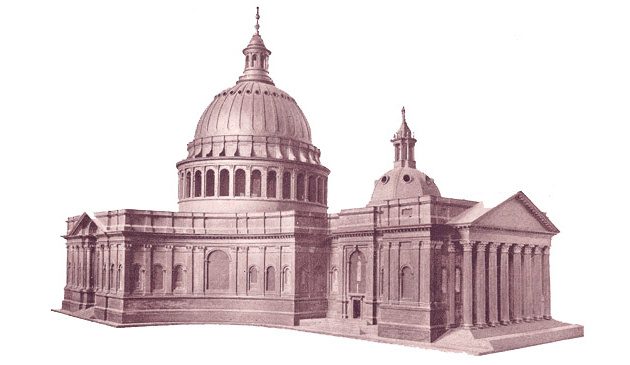The Great Fire of London

Wenceslaus Hollar’s contemporary illustration he named ‘The Prospect of this Citty, as it appeared from the opposite Southwarke side in the fire time’, which shows how the wind was spreading the conflagration from east to west. It was made from his imagination because he wrote after the event that it had “passed by us here at Whitehall. For all that there were great fears for one day that the flames would reach us here, I never saw them…”.
During the late afternoon the fire reached London’s main shopping street at Cheapside and the centre of the City, arriving at the Royal Exchange, which burned during the evening. The many statues of kings within the building were all destroyed but that of the building’s founder, Sir Thomas Gresham, somehow survived. In the early hours of Monday morning James Hickes, the senior clerk at the General Letter Office in Threadneedle Street, abandoned the building with his wife and family and fled to Barnet, carrying whatever post they could manage. Several hours later the building burnt down with all the remaining letters. From Barnet he issued a circular to postmasters around the country with news of the calamity and instructing that all official post be directed to him from where he could arrange its delivery to Whitehall.
A mass exodus took place of people fleeing with everything they could carry to the fields that surrounded London, at Islington, Finsbury and Highgate. Camps full of pathetic shelters grew at Hatton Garden, Lincoln’s Inn Fields, Gray’s Inn Fields and beyond the tenements of St. Giles Fields. Businessmen in all the surrounding streets moved as much stock as they could arrange to a safe location elsewhere. Those living away from the fire who owned carts and wagons made good money by offering their services for a high price. The general chaos allowed crime to take place unchecked and many people looted whatever they could from the deserted warehouses. In some cases wealthier people hired porters to move their belongings, never to see them again. The financiers of Lombard Street cleared their premises and the booksellers and stationers of Paternoster Row moved their stock to either the church of St. Faith’s in the crypt of St. Paul’s Cathedral, Christchurch Newgate, or Stationers’ Hall to the west of the cathedral.
By the end of Monday a further 39 more parishes had perished during the day, including another eight Livery Company Halls (including the newly-built Cutlers’ Hall in Cloak Lane) and Baynard’s Castle at Blackfriars. The total area of devastation stretched in a great arc, covering several hundred acres, including the very central parts of the City. The main spread was westwards from Pudding Lane, particularly along the riverbank where it stretched about 1,500 metres along the bank of the river, almost to the very western edge of the City of London. Northwards it had crept in the direction of Bishopsgate but there was a gradual and dangerous creep eastwards against the direction of the wind towards the Tower.
The ideal man to take command would have been the military commander George Monck, Duke of Albermarle but he was otherwise engaged with the failed attempt to fight the Dutch Navy. On Monday the King gave overall command of the situation to his brother, the Duke of York, always a firm (but headstrong) leader in a crisis, and he began preparing plans.
The Duke arranged for five command posts to be set up in an arc at Temple Bar, Clifford’s Inn Gardens, Fetter Lane, Shoe Lane and Cow Lane, each manned by parish constables with a team of 100 men, together with 30 foot soldiers under the command of an officer. The command posts were provided with rations of bread, cheese and beer. He also stationed three royal courtiers at each with cash to reward those men who worked through the night, and with authority from the King to order the demolition of buildings. Three advance posts were stationed closer to the fire at Aldersgate, Cripplegate and Coleman Street under the command of two gentlemen each. The most trusted courtiers were stationed at Temple Bar with orders to prevent the spread of the fire beyond the City to Whitehall and Westminster. Richard Browne was based at Cow Lane and the Mayor at Cripplegate. James himself moved backwards and forwards between the stations and took personal control of the line along the Fleet River around Fleet Street. Soldiers were ordered to patrol the refugee camps to keep order and prevent looting.
Things did not go according to the Duke’s plan. Instead of moving in an orderly advance, large sparks blown in the wind set Salisbury Court alight, behind his position in the west, and he and his men had to make a retreat to Somerset House on the Strand. With the sudden westwards movement it was decided that the Treasury should be evacuated to Nonsuch House in Surrey and boats and carriages were hired for that purpose.
The fire continued to rage along Cheapside and its surrounding alleys during Monday night, destroying a further six parishes, Mercers’ Hall and the great St. Mary-le-Bow church. On Tuesday morning another six churches went up in flames and two more Company halls. London’s goldsmiths had already moved all their coin and bullion to the Tower for safe-keeping, only to move it on again to the Palace of Whitehall as the fire crept ever nearer. Sir Charles Doe commandeered a wagon for the sum of five pounds to move their records and collection of plate from their hall in Foster Lane to a house in Edmonton and Goldsmiths’ Hall was gutted later in the day.

